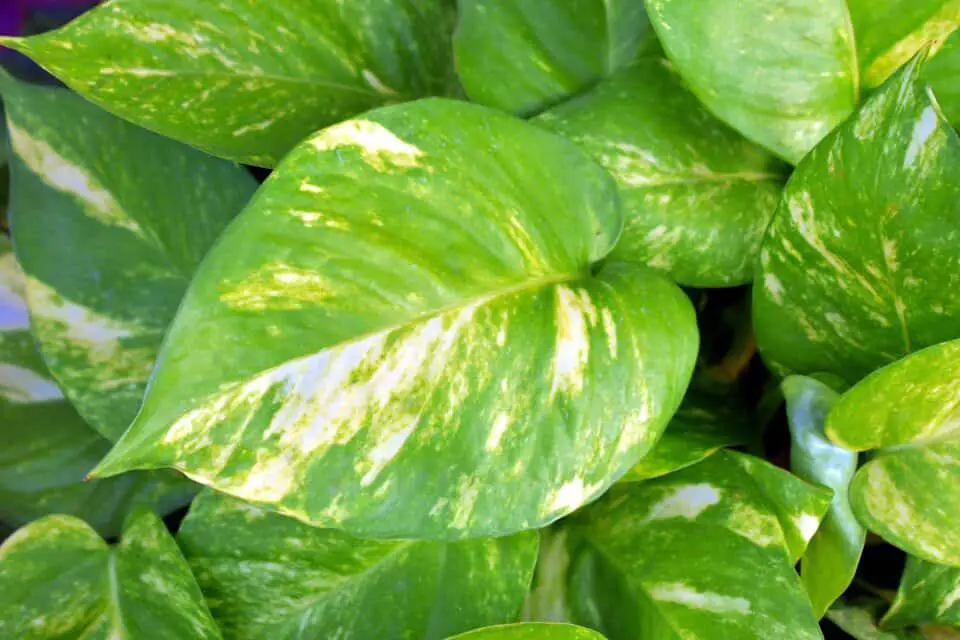Some links in the post are affiliate links and I get a commission from purchases made through some links found in the post.
Want a trailing houseplant that’s easy to care for? No need to look any further. Your hunt for information comes to an end here.
One of the houseplants that requires the least amount of maintenance is and always has been the Pothos.
It’s possible to grow Pothos indoors all year round, and it proliferates, adding between 12 and 18 inches of length in just a month.
Pets should be kept away from this plant because of its toxicity. Like most of us, you prefer easy-to-care-for houseplants that don’t require much maintenance.
In addition to being beautiful, the pothos plant is known for being extremely hardy, making it one of the easiest houseplants to grow.
Apart from adding color and texture to your home, Pothos are among the best plants for purifying the air you breathe.
Increased humidity and increased carbon dioxide removal are two other benefits of the plants. Pothos has always been seen as one of the easiest houseplants to take care of, which remains true today.
In an indoor environment, the pothos plant tends to stay within a distance of six to ten feet. Waxy, variegated leaves with a pointed heart shape and a wide range of colors are typical of this plant.
The hue of the new growth on golden pothos plants is pale green. As it ages it turns a emerald green with parts of the leaves becoming a cream yellow.
If your plant starts to become all green, this could be due to sunburn, not enough water, not enough nitrogen, the incorrect temperature and humidity and the fertilizer being incorrect.
What Color Should Golden Pothos Leaves be?
 Indoors, the pothos plant typically stays between six and ten feet tall. Its leaves are brilliant and waxy, with a distinctive heart-shaped tip, and are typically green or variegated with white, yellow, or pale green.
Indoors, the pothos plant typically stays between six and ten feet tall. Its leaves are brilliant and waxy, with a distinctive heart-shaped tip, and are typically green or variegated with white, yellow, or pale green.
It is uncommon for them to flower or produce berries, especially indoors, but select types can create tiny, white flowers with small berries that lack petals.
Types of Pothos
There are hybrids of Epipremnum aureum, although only a few cultivars are commonly grown as houseplants.
The most popular is aureus or golden Pothos, found on many bookshelves and plant hangers worldwide.
Neon Pothos
Even while you won’t find neon pothos in nightclubs, you’ll still appreciate their eye-catching, neon-colored leaves.
The leaves of the neon pothos are noticeably brighter and more brilliant than those of other members of the pothos family, and they occasionally take on an appearance almost identical to that of an incandescent yellow.
Satin Pothos
The satin pothos is so named because its dark green leaves are flecked with silvery gray, giving them a satin-like luster.
The big, heart-shaped leaves of the satin pothos make it a popular addition to home plant nurseries.
Leave the plant in bright, indirect light to preserve the distinctive variegation on the leaves of satin pothos.
Golden Aureum
Golden Pothos has variegated golden-yellow leaves, as you may assume from its name.
The Golden Pothos is a plant native to numerous places in southeast Asia, including the Solomon Islands.
Pothos kinds often lack yellow variegation that thrives in low light circumstances, so ensure that your golden Pothos receives at least one to two hours of moderate sunlight daily.
Marble Queen
The most popular cultivar, Marble Queen, grows quite slowly. The leaf has an intricate pattern of stripes and veins, and its base color is typically white rather than green.
There is less demand for marble queens than for golden Pothos because they are more challenging to care for. However, its moderate growth makes it ideal for spaces with limited room.
You may also like: Hawaiian Pothos Vs Golden Pothos
Why is my Golden Pothos All Green?
Pothos are tolerant houseplants that are not picky about water or light, making them an excellent choice for beginning gardeners.
However, low maintenance does not equate to invincibility! Pothos can become stressed when growing conditions are not optimal.
Insufficient light, water, or nitrogen will cause the leaves of Pothos to turn light green.
Pothos vines are resilient and can be saved with deep watering and high-quality indoor plant food. New growth on healthy pothos plants will be naturally light green.
Causes of Light Green Leaves on Pothos
As part of their healthy development, pothos plants can produce leaves with a light green hue.
New Growth

The hue of the new growth on golden pothos plants is pale green. Regularly shaped new stems and leaves emerge from the ends of the vines or the place where the Pothos has been clipped.
As these leaves grow and produce more chlorophyll, they will darken. Golden pothos leaves often become darker green in low-light environments because they must create more green chlorophyll to convert light into carbs.
Young plants typically begin with relatively pale leaves that darken as they mature. Observe the name of the pothos plant to determine if it will change or develop variegation as it grows.
Why Golden Pothos Leaves Turn all Green
If there is an issue with the plant’s nutrition, water, soil, or amount of light, the pothos’ leaves may turn all green. Check out the following points to determine if they are causing the green leaves on your pothos plants.
1) Sunburn
Sunburn is a crucial factor in the lightening of pothos plant leaves. A plant exposed to full, direct sunlight will immediately exhibit indications of harm with light green leaves that turn yellow or brown.
Look for pale green, yellow, and brown patches along the leaf edges.
Additionally, direct sunlight can easily scorch a plant near a window. The window glass will heat up and reflect heat towards the plant, causing the leaves to burn rapidly.
Move plants away from direct sunshine and into an area that receives filtered morning light.
Avoid abruptly transferring an indoor pothos plant outside into direct sunshine. They will thrive in a shade house with other tropical plants or on your verandah if adequately watered.
2) Not Enough Water
Insufficiently watered golden pothos plants might develop green leaves before they become yellow and brown.
The leaves will droop before they lose their pigment and turn pale green Identifying this issue can save the plant’s leaves from turning yellow or brown.
Take the entire plant pot to the sink or outdoors and thoroughly water it. Permit the water to drain before bringing it back inside fully.
3) Not Enough Nitrogen
Lack of nitrogen is another significant factor contributing to the green color of golden pothos leaves.
Nitrogen is required for plants to produce the chlorophyll that gives their leaves their green hue. As the plant lacks nitrogen, it will also lack chlorophyll, causing the leaves to become lighter in color before going yellow.
Inadequate potting soil, overwatering, which washes nitrogen out of the soil, and root rot can all contribute to a deficiency in nitrogen.
4) Temperature and Humidity
Pothos requires consistently higher than 50 degrees Fahrenheit, and they do best when kept in an environment with an average temperature ranging from 65 to 75 degrees Fahrenheit.
In addition, pothos plants prefer high humidity. Therefore you can boost the moisture around the plant by placing it in a kitchen or bathroom.
Nevertheless, the plant is quite resistant and can grow even in low-humidity situations, so there is no need to purchase a humidifier.
5) Fertilizer
 Pothos plants do not require a hefty diet. On the other hand, given that most potting soils are deficient in minerals, you can improve the plant’s nutrition by fertilizing it once or once every month with any balanced houseplant fertilizer.
Pothos plants do not require a hefty diet. On the other hand, given that most potting soils are deficient in minerals, you can improve the plant’s nutrition by fertilizing it once or once every month with any balanced houseplant fertilizer.
After two weeks, sprinkle a slow-release indoor plant fertilizer on the top of the Pothos’s soil to continue feeding it for the next six months. Remember to treat your plant with vital nutrients in the spring and fall of each year.
After a deep watering, the leaves should return to their upright position overnight. If the disease is detected early enough, the plant’s green leaves will darken as it recovers.
If you take your Pothos outside to deep water it, allow it to drip in the shade to prevent sunburn.
Final Thoughts
If the Pothos has new growth or is variegated, its leaves will naturally be green. Alternatively, sunburn, a lack of nitrogen, overwatering, or a lack of nitrogen could be the cause.
Eco oil can use to eliminate aphids and mealybugs. Pothos are resilient and will recover after the situation has been resolved.


